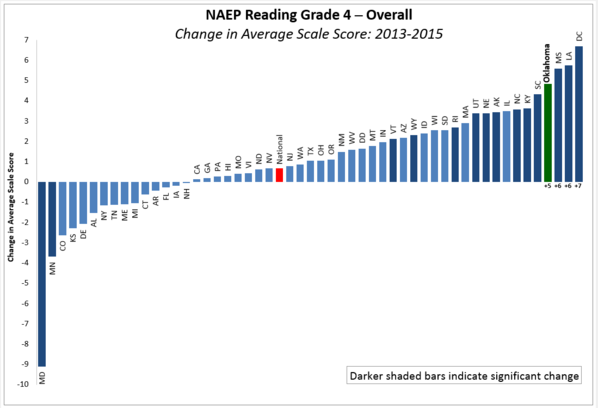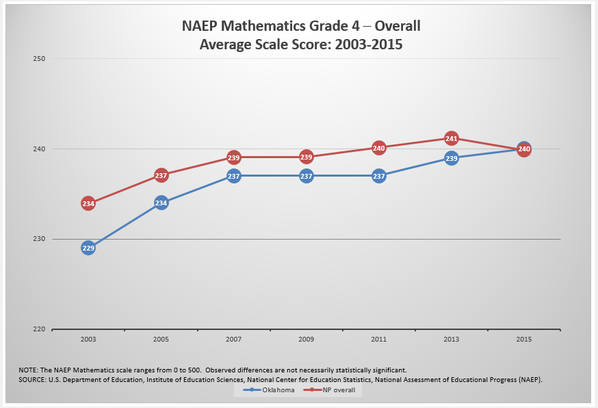|
OKLAHOMA CITY (Oct.
28, 2015) — Oklahoma reading scores in the 2015 National Assessment of
Educational Progress (NAEP) represent significant growth for fourth-grade
students. The state had the third-largest gain in the country, up 5 points from
217 in 2013 to 222 this year, putting Oklahoma above the national average of 221.
Oklahoma students showed growth in three of four
grade/subject combinations; fourth-grade reading and math and eighth-grade
reading. However, average scores nationwide declined in three of four
grade/subject combinations. The NAEP results were released earlier today in
Washington D.C.
In
fourth-grade reading, Oklahoma was among just 13 states/jurisdictions to see
growth.

State Superintendent of Public Instruction Joy Hofmeister
sees the increase as evidence that the Reading Sufficiency Act, or RSA, is
working, as the state has given increased focus on higher reading achievement.
“Our focus on early-learning reading is working. Through
RSA, we are reaching schoolchildren who need help the most,” Hofmeister said. “It
is important that we continue to build momentum with literacy by fostering
parent engagement with strategic reading interventions for students.”
In 2014, for the first time, third-grade
students who did not score at least “limited knowledge” on the state reading
test and who did not qualify for an exemption under RSA’s retention policy were
referred to state-mandated reading teams at their schools. These teams subsequently
decided whether each child should advance to the fourth grade or be retained in
third grade for remediation.

Oklahoma’s eighth-grade reading score average was 263, better than 262 in 2013 and 260 in 2011.
The national average for eighth-grade reading this year was 264. Oklahoma’s reading scores in this grade have been increasing since a low of 259 in 2009.
Oklahoma fourth graders taking the national math assessment earned an average score of 240, up from 239 in 2013 and 229 in 2003. That aligned the state to this year’s national average of 240.
But in eighth-grade math, Oklahoma dropped from 276 in 2013 to 275 in 2015 and remains well below this year’s national average of 281.
 “This confirms our need for stronger attention in math, especially at the middle school level. Our students lag behind their national counterparts, and it is imperative that we change the momentum,” said Hofmeister. “The need for ensuring a deeper foundation and higher standards is greater than ever. Our writing teams charged with developing Oklahoma’s academic standards for English language arts and mathematics have been very thorough. I am confident we will soon have standards that will better prepare students for higher education and 21st-century careers.”
NAEP reveals that the percentage of Oklahoma students scoring at or above proficiency is 37 percent in fourth-grade math and 23 percent in eighth-grade math.
The national percentage at or above math proficiency is 39 percent for fourth grade and 32 percent for eighth grade.
Hofmeister says, “This is a call to action.”
In reading, the percentage of Oklahoma students scoring at or above proficient is 33 percent in fourth grade and 29 percent in eighth grade.
The national percentage at or above proficiency is 35 percent for fourth grade and 33 percent for eighth grade.
*Compared to the nation, Oklahoma is:
- above 14 states, not significantly different from 20 states and below 17 states in fourth-grade reading;
- above 7 states, not significantly different from 16 states and below 28 states in eighth-grade reading;
- above 12 states, not significantly different from 22 states and below 17 states in fourth-grade math; and
- above 5 states, not significantly different from 9 states and below 37 states in eighth-grade math.
*numbers represent states and jurisdictions; including the District of Columbia and Department of Defense schools
“These results show we must take bold action in order to
truly compete,” said Hofmeister. “While Oklahoma did see growth in NAEP
assessments, we are still in the middle of the pack nationally. Our goal is to
be a state other states strive to reach. We are on the right track with RSA,
and I am confident our new academic standards will put us on the pathway to success.”
Federal law requires that states and districts receiving Title I funding participate in the NAEP reading and math assessments every two years.
NAEP chooses samples of students representative of the state’s student
population. Approximately 4,400 Oklahoma students in 260 Oklahoma schools were
tested. The results of these tests are reported in the Nation’s Report Card. NAEP
can be used to compare Oklahoma to regions with similar demographics, other states and the nation.
###
|